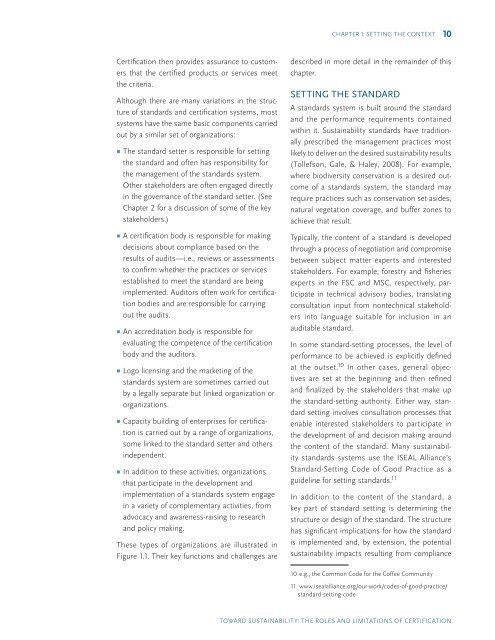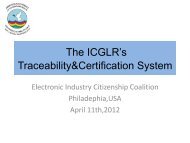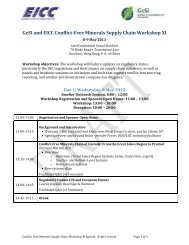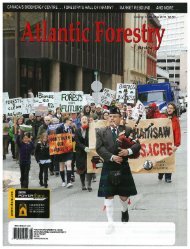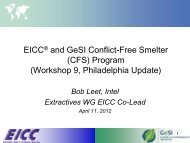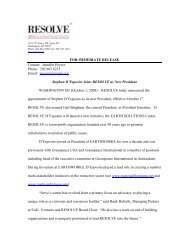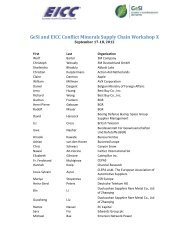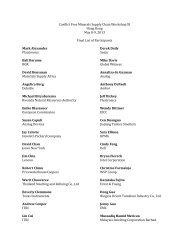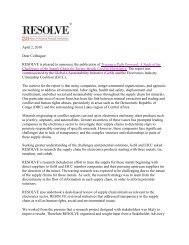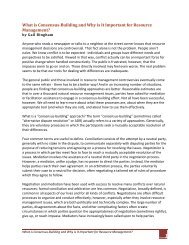Toward SuSTainabiliTy: The roleS and limiTaTionS of ... - Resolve
Toward SuSTainabiliTy: The roleS and limiTaTionS of ... - Resolve
Toward SuSTainabiliTy: The roleS and limiTaTionS of ... - Resolve
Create successful ePaper yourself
Turn your PDF publications into a flip-book with our unique Google optimized e-Paper software.
Chapter 1: Setting the Context 10Certification then provides assurance to customersthat the certified products or services meetthe criteria.Although there are many variations in the structure<strong>of</strong> st<strong>and</strong>ards <strong>and</strong> certification systems, mostsystems have the same basic components carriedout by a similar set <strong>of</strong> organizations:▪ <strong>The</strong> st<strong>and</strong>ard setter is responsible for settingthe st<strong>and</strong>ard <strong>and</strong> <strong>of</strong>ten has responsibility forthe management <strong>of</strong> the st<strong>and</strong>ards system.Other stakeholders are <strong>of</strong>ten engaged directlyin the governance <strong>of</strong> the st<strong>and</strong>ard setter. (SeeChapter 2 for a discussion <strong>of</strong> some <strong>of</strong> the keystakeholders.)▪ A certification body is responsible for makingdecisions about compliance based on theresults <strong>of</strong> audits—i.e., reviews or assessmentsto confirm whether the practices or servicesestablished to meet the st<strong>and</strong>ard are beingimplemented. Auditors <strong>of</strong>ten work for certificationbodies <strong>and</strong> are responsible for carryingout the audits.▪ An accreditation body is responsible forevaluating the competence <strong>of</strong> the certificationbody <strong>and</strong> the auditors.▪ Logo licensing <strong>and</strong> the marketing <strong>of</strong> thest<strong>and</strong>ards system are sometimes carried outby a legally separate but linked organization ororganizations.▪ Capacity building <strong>of</strong> enterprises for certificationis carried out by a range <strong>of</strong> organizations,some linked to the st<strong>and</strong>ard setter <strong>and</strong> othersindependent.▪ In addition to these activities, organizationsthat participate in the development <strong>and</strong>implementation <strong>of</strong> a st<strong>and</strong>ards system engagein a variety <strong>of</strong> complementary activities, fromadvocacy <strong>and</strong> awareness-raising to research<strong>and</strong> policy making.<strong>The</strong>se types <strong>of</strong> organizations are illustrated inFigure 1.1. <strong>The</strong>ir key functions <strong>and</strong> challenges aredescribed in more detail in the remainder <strong>of</strong> thischapter.Setting the St<strong>and</strong>ardA st<strong>and</strong>ards system is built around the st<strong>and</strong>ard<strong>and</strong> the performance requirements containedwithin it. Sustainability st<strong>and</strong>ards have traditionallyprescribed the management practices mostlikely to deliver on the desired sustainability results(Tollefson, Gale, & Haley, 2008). For example,where biodiversity conservation is a desired outcome<strong>of</strong> a st<strong>and</strong>ards system, the st<strong>and</strong>ard mayrequire practices such as conservation set-asides,natural vegetation coverage, <strong>and</strong> buffer zones toachieve that result.Typically, the content <strong>of</strong> a st<strong>and</strong>ard is developedthrough a process <strong>of</strong> negotiation <strong>and</strong> compromisebetween subject matter experts <strong>and</strong> interestedstakeholders. For example, forestry <strong>and</strong> fisheriesexperts in the FSC <strong>and</strong> MSC, respectively, participatein technical advisory bodies, translatingconsultation input from nontechnical stakeholdersinto language suitable for inclusion in anauditable st<strong>and</strong>ard.In some st<strong>and</strong>ard-setting processes, the level <strong>of</strong>performance to be achieved is explicitly definedat the outset. 10 In other cases, general objectivesare set at the beginning <strong>and</strong> then refined<strong>and</strong> finalized by the stakeholders that make upthe st<strong>and</strong>ard-setting authority. Either way, st<strong>and</strong>ardsetting involves consultation processes thatenable interested stakeholders to participate inthe development <strong>of</strong> <strong>and</strong> decision making aroundthe content <strong>of</strong> the st<strong>and</strong>ard. Many sustainabilityst<strong>and</strong>ards systems use the ISEAL Alliance’sSt<strong>and</strong>ard-Setting Code <strong>of</strong> Good Practice as aguideline for setting st<strong>and</strong>ards. 11In addition to the content <strong>of</strong> the st<strong>and</strong>ard, akey part <strong>of</strong> st<strong>and</strong>ard setting is determining thestructure or design <strong>of</strong> the st<strong>and</strong>ard. <strong>The</strong> structurehas significant implications for how the st<strong>and</strong>ardis implemented <strong>and</strong>, by extension, the potentialsustainability impacts resulting from compliance10 e.g., the Common Code for the C<strong>of</strong>fee Community11 www.isealalliance.org/our-work/codes-<strong>of</strong>-good-practice/st<strong>and</strong>ard-setting-code<strong>Toward</strong> Sustainability: <strong>The</strong> Roles <strong>and</strong> Limitations <strong>of</strong> Certification


